I’m a physiotherapist, bike fitter and racer, and this is your definitive guide to knee pain and cycling
Nicole Oh guides you through the most common injury experienced by cyclists
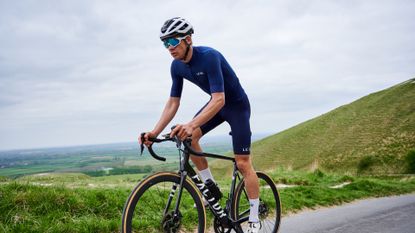
Knee pain is one of the most common injuries experienced by cyclists, and it’s usually caused by overuse, or, overload. The prevalence is understandable considering our sport involves a repetitive movement performed over long hours in the saddle.
A UK study in 2023 reported that 48% of cyclists had experienced knee pain at some point, with 26.1% experiencing it in the past month. Other studies have shown yearly prevalence of 25.8% in a group of competitive and non-competitive cyclists, and 23% in a group of professional cyclists.
Overuse injuries occur following repetitive loading, which - without proper recovery - lead to a chronic cycle of improperly healed inflammation. Since the knee is a hinge joint, which doesn’t operate outside of a single plane, it can be subject to rotational stresses and torsion when stuck between a foot, fixed to the pedal, and hip, fixed to the saddle.

Nicole Oh is a Sydney born and trained physiotherapist. Nicole’s interest has always been in the treatment of sports injuries, as well as biomechanical assessments and sports injury rehabilitation. She has also completed training in acupuncture and clinical pilates. As a competitive road racer herself, in the UK Nicole competed at national level.
Types of knee pain
There are four main areas of knee pain:
- Anterior knee pain - pain at the front of the knee
- Posterior knee pain - pain at the back of the knee
- Medial knee pain - pain on the inside of the knee
- Lateral knee pain - pain on the outside of the knee
To explain these types of knee pain, we’re going to have to use some more medical terms, which you may hear if you visit a physiotherapist or professional. Bear with me, we’ll get to solutions and recommendations, soon.
Pain at the front of the knee
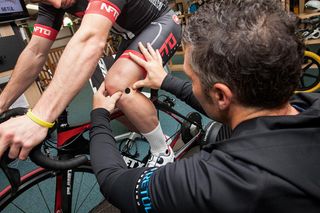
Pain at the front of the knee may be down to incorrect tracking
Anterior knee pain is by far the most common, and the most common cause of this pain is from the Patellofemoral joint. Other less common sources of anterior knee pain are from the patella (or quads) tendon, fat pad or bursas over the knee.
Patellofemoral pain is often described as a vague pain under or around the patella, which is felt during or after loading. There are few definitive medical tests, and scans will often show minimal structural changes.
Get The Leadout Newsletter
The latest race content, interviews, features, reviews and expert buying guides, direct to your inbox!
During knee movement, the patella (knee cap) tracks along the femur (thigh bone) in what we call the ‘trochlea groove’. Patellofemoral pain occurs when there is a concentration of pressure on one area of the joint, which leads to irritation and inflammation of the soft tissues around it. This is often due to - in layman’s terms - incorrect tracking of the patella and imbalanced forces acting on the joint.
What causes incorrect tracking? It’s usually weakness or poor activation of the VMO muscle - located on the inside of the quad - which serves to pull the patella medially and stabilise it in the trochlear groove; pain or swelling in the knee can also inhibit the VMO.
The knee dropping inwards under load - called Dynamic knee valgus - can also cause incorrect tracking, by altering the alignment of the groove. This is due to a lack of rotation control at either the foot, or hip, or both.
Pain at the back of the knee
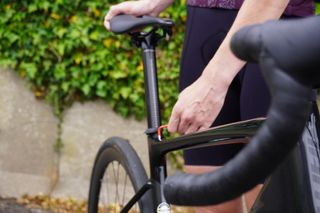
A saddle that is too high is often the cause of pain behind the knee
Posterior knee pain is generally the result of overload of the hamstring (or less commonly, calf) tendons where they attach at the back of the knee, and the culprit is very often a saddle that is too high, or set too far back, resulting in overextension of the knee at the bottom of the pedal stroke. The popliteus - a muscle running behind the knee - can also be a source of posterior knee pain if it is working too hard to control rotation of the foot on the pedal.
Pain on the outside or inside of the knee
Lateral knee pain - on the outside of the knee - is most commonly due to compression at the ITB insertion on the outside of the knee. It can be caused by muscle imbalances around the hip, poor control of knee rotation, or inappropriate stance width and saddle position.
The main culprit in medial knee pain - on the inside of the knee - is bursitis or tendinopathy of the area on the inside of the knee where the sartorius, gracilis and semimembranosus tendons attach, called the pes anseurinus. This is also likely due to poor control of knee rotation and inappropriate stance width, resulting in the knee dropping and rotating inwards excessively.
Causes of knee pain
Most cycling-related knee pain can be attributed to a combination of the following:
- Individual anatomical or biomechanics factors
- Bike set up
- Training load errors
We'll look at each of these, independently.
Causes to do with the body
Let’s start with the cyclist themselves. Muscle imbalance, weakness and tightness are primary factors.
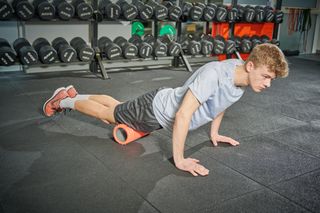
Stretching, foam rolling and massage can help to relive tightness
As mentioned previously, poor VMO activation and/or tightness or overactivity of the outside quad muscle and ITB can alter patella tracking, increasing load though one part of the knee joint. If the glutes are not providing their fair share of power production - either due to weakness or poor recruitment - this will increase demand on the quads and hence stress on the patella which they attach to.
Muscle imbalance also has a role in ITB-related pain. Recruitment of TFL - a much smaller muscle along the outer thigh - over glute med to stabilise the hip can result in excessive tension on the ITB, resulting in pain at the outside of the knee, or contributing to incorrect tracking of the patella.

Exercises to help recruit the glute muscles may be needed
Weakness in any of the muscle groups around the hip or knee can lead to alterations in pedalling technique when under high load or when fatigued. This is particularly important in regards to the glutes and lateral stabilisers of the hip which control rotation of the knee. The same can be said for the muscle that stabilise the core and pelvis, which provide a stable base for efficient transfer of power to the pedals.
Muscle tightness can also be problematic. Most cyclists' quadriceps, hamstrings, glutes and hip flexors will tighten with prolonged riding due to the repeated contraction and shortening of these muscle groups, which can increase forces on the knee.
Causes to do with the bike
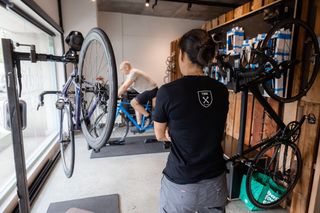
Addressing your bike fit may be the answer to knee pain when cycling
Almost all aspects of bike fit can have an effect on knee pain, however, common culprits are issues with saddle height, cleat and foot alignment and stability, and crank length.
An inappropriate saddle height and setback will result in under-extension or over-extension of the knee at the bottom of the pedal stroke. Whilst an excessively low saddle can certainly increase the load through the patellofemoral joint a saddle that is too high is just as likely to cause issues at the knee joint. Any increase in seat height above optimal will create some sort of instability of the foot on the pedal or pelvis on the saddle, challenging the rotation control of the knee.
A saddle that is too high can create a toe down pedalling style with a struggle to reach the bottom of the pedal stroke, which is a more unstable position for the ankle joint and foot. Cleats that are set too far forward can also create this issue. The pelvis may also tilt (usually to one side) on the saddle if it is too high. The leg will tend to fall into internal rotation on the downstroke.
Furthermore, a saddle that is too high will affect the function of the hamstrings. The hamstrings are required to control knee extension at the bottom of pedal stroke. A high saddle can increase strain on the hamstrings as it is forced to work beyond its optimal range resulting in pain or injury. Alternatively, the hamstrings may disengage at the bottom of the pedal stroke, losing control of extension and loading the quads and patella.
Stability of the foot and alignment of the knee can be addressed via cleats and/or pedals. Ideally, we want the hip, knee and foot to operate in a straight line to reduce torsion forces on the knee. Since the foot is fixed, we need to align the foot with the knee, not the other way around, which is done by placing the cleats to the inside or outside of the shoe to widen or narrow stance width. Stance width can also be increased by using pedal spacers or fitting pedals with longer spindles.
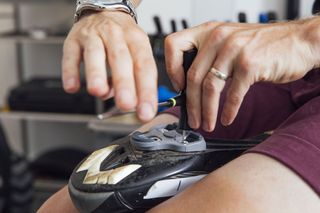
Cleat set up can make all the difference to cycling knee pain
Cleats with some amount of float will allow the feet and knees to work outside of a set plane of movement, as opposed to fixed float cleats. The angle the cleat is set also needs to be considered. The foot does not want to be working against the edge of the cleat float in either direction, and hence the cleat may need to be angled slightly heel in or heel out accordingly. Getting the right cleat angle on a shoe will mean there is less reliance on float to keep the foot, and knee, within the available range, taking load off the popliteus.
The use of wedges in the shoe or under the cleat may be needed to alter the alignment of the foot, and hence the knee, and optimise tracking. Cleat shims can be used to correct leg length discrepancies if required, which can cause asymmetrical loading on the bike.
A crank that is too long will increase the closed angle of the hip and knee joints at the top of the pedal stroke, with increased compression of these joints possibly resulting in pain. It may also cause compensation strategies such as pelvic rocking and knee out-flaring. This issue is further exacerbated if the rider also has restricted hip or knee flexion range of motion.
Training load errors
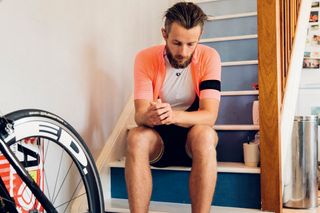
Simply doing too much, too soon, can result in knee pain
Inappropriate training load or training errors are a factor in many overuse and overload injuries, not just of the knee. It can be described as a training load that is beyond the individual’s capacity, and can occur in a range of situations. Training load error can result in pain and injury in itself, without any intrinsic (body) and extrinsic (bike) contributing factors.
Overload is often associated with a rapid increase in volume, intensity, or frequency, especially if increased all at once; in other words, doing “too much, too soon”. This could be early on after adopting a new hobby, or it may follow a period of reduced training or time off training (eg. following an injury or illness, or off-season break), in which the body has de-conditioned and can no longer adapt to previous training loads. Adding too much high intensity training with a lack of base conditioning can also be a factor.
Making significant positional or equipment changes can increase stress on tissues, especially if done during a period of high training load, when the body is close to its limit of load tolerance already.
An excessive increase in muscular load, such as pushing hard gears at low revolutions, for example during long climbs, can result in patellofemoral pain. This type of riding is also more likely to result in fatigue-induced changes in pedalling technique, such as heel dropping and knee valgus, putting added stress on structures at the back and sides of the knee.
Finally, if the body is not allowed sufficient recovery, it can lead to poor tissue repair and injury. This includes inadequate nutrition and sleep.
How to fix your knee pain
The first thing to do is to determine what the injured structure is and the severity of the injury. A Physiotherapist with a knowledge of cycling will be able to help you with this, as well as guide your rehab to make a full return to cycling.
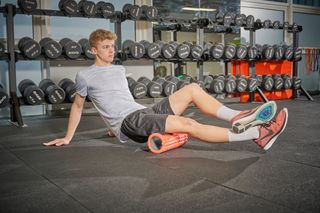
Foam rolling areas which are tight will help get you on the road to recovery
Depending on the problem, action will need to be taken to relieve pain, restore normal movement, and retrain muscle function. This may involve releasing or stretching tight structures such as the quads, TFL/hip flexors, hamstrings or glutes. Soft tissue work, stretching, or dry needling are some techniques used to do this, as well as at home stretches, foam rolling or trigger point ball self-releases.
You will likely need to retrain some muscle groups. For example, the VMO (inside thigh muscle) and gluteus medius (side bottom/hip muscle) are often dysfunctional in people with knee pain. You may need to be taught how to activate these muscles, and then strengthen them. But it is often not just the muscles around the knee that need to be addressed; some of the muscles around the pelvis/hip, foot and trunk may need attention as well.

Exercises to help you recruit the glute muscles will be on the menu
Unloading and relative rest is important to prevent the injury from progressing, but this usually doesn’t mean you need to, or should, stop cycling completely. Shorter distances, fewer hills, lower gears, and rest days in between rides may enable you to maintain a degree of conditioning without aggravating your knee pain. Chances are, you will also need to modify your training load, building up gradually and monitoring the response.
Adjustments to your bike fit may be needed if it has not been set up optimally in the first place. The bike can also be adjusted to either temporarily unload a structure or to accommodate a current weakness, such as poor flexibility or movement control, then reviewed as the issue resolves. A comprehensive bike fit will address these issues.
Finally, it is always helpful to identify possible causes that could have contributed to the issue. This can include changes to your bike, training, or even everyday activities. Often an awareness of potential overload and early intervention can stop a niggle turning into an injury that keeps you off your bike.
Knee pain rehab success story
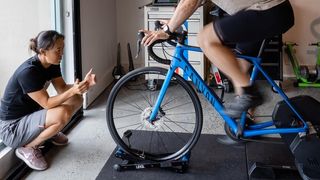
Changes to the bike, training load and strength and conditioning work all helped get Matt back on the bike, pain free
A cyclist with a long history of patellofemoral pain came and saw me in clinic, initially for a bike fit. We’ll call him Matt. Matt had experienced both left and right knee pain since 2014, with the left recently giving him more trouble. MRI’s in the past showed no structural abnormalities. He had had 3 previous bike fits, the last being in 2021 when he purchased his most recent bike.
During the physical screening, I found that Matt had tight TFL, glute med weakness, decreased eccentric quads control, and decreased hip flexion ROM. On the bike, his saddle was too high and set back, the reach was too long, the handlebars were too high, creating insufficient drop, and he had asymmetrical knee tracking. There was a suspicion that the bike may have actually been too big for him.
We moved the saddle down by 20mm and forward to the available limit. We shortened the stem by 20mm and lowered it by 25mm. These changes created far more stability of his feet and pelvis, and eliminated over-extension of the knee at the bottom of the saddle stroke. We titled the saddle nose down slightly to allow for more pelvis rotation and saddle comfort and facilitate hip hinge, then placed a varus forefoot wedge in both shoes to further stabilise the feet. In the end, Matt ended up choosing to buy a new (smaller) bike, at which point he shortened the crank length from 172.5 to 165mm, allowing more room at top dead centre for his knees and stiff hips.
As well as the bike fit changes, Matt also undertook a strengthening program, focussed mainly on progressively strengthening the VMO and quads muscles. He had done some previous rehab work with a Physio last year, which focussed mainly on gluts and core. He was also given some stretches and releases to do at home for this TFL, glute med and lateral quads.
Training initially consisted of zone 2 work only (monitored by a power meter), building up volume first. He then added threshold interval work 1-2 times a week.
Matt has been able to build back up to 10 hours of training a week, including long rides and hill work, although he does occasionally have a flare up of his patellofemoral pain, which is managed through load modification. Furthermore, he is feeling better activation of his glute muscles when riding.

Thank you for reading 20 articles this month* Join now for unlimited access
Enjoy your first month for just £1 / $1 / €1
*Read 5 free articles per month without a subscription

Join now for unlimited access
Try first month for just £1 / $1 / €1
Nicole Oh is a physiotherapist and bike fitter, with training in biomechanical assessments, sports injury rehabilitation, acupuncture and clinical pilates.
A competitive cyclist with a background in triathlon, Nicole raced at National level in the UK, also managing and co-founding the Les Filles Racing Team. Having moved to Sydney, she works as a physiotherapist at The Body Mechanic and continues to race competitively.
-
 From Peru to Ukraine: 'My motorcycle friends are p*ssed because I spend so much time cycling'
From Peru to Ukraine: 'My motorcycle friends are p*ssed because I spend so much time cycling'Adventurer, philanthropist, motorcyclist and cyclist Neale Bayly has ridden in some far-out places: 'This is deep cycling', he says
By James Shrubsall Published
-
 'I would love to try it' - Tadej Pogačar hints at attempting to win all three Grand Tours in one year
'I would love to try it' - Tadej Pogačar hints at attempting to win all three Grand Tours in one yearAfter winning the Triple Crown of the Giro d'Italia, Tour de France and the World Championships, Pogačar wants more
By Chris Marshall-Bell Last updated